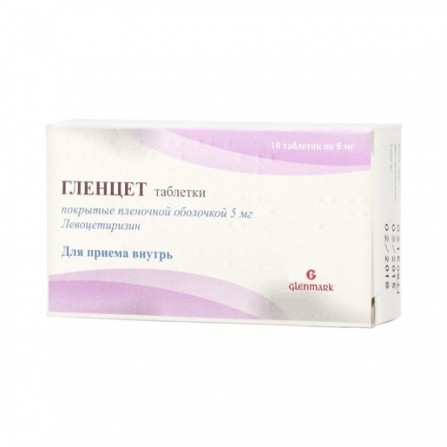Glencet pills coated 5mg N10
Condition: New product
1000 Items
Rating:
Be the first to write a review!

More info
Active ingredients
Levocetirizine
Release form
Pills
Composition
Tablets, film coated 1 tab. Levocetirizine dihydrochloride 5 mg
Pharmacological effect
Levocetirizine, an enantiomer of cetirizine, a competitive histamine antagonist, blocks histamine H1 receptors, the affinity for which is 2 times higher than that of cetirizine. It prevents the development and facilitates the course of allergic reactions, has anti-exudative, antipruritic effect, practically does not have anticholinergic and antiserotonin action. In therapeutic doses, the sedative effect is very poorly expressed. The effect begins 12 minutes after taking a single dose in 50% of patients, after 1 h in 95% and lasts for 24 hours.
Pharmacokinetics
Pharmacokinetics is linear. Rapidly absorbed when taken orally; reception of the poor does not affect the completeness of absorption, but reduces its speed. Bioavailability - 100%. The time to reach Cmax in the blood - 0.9 h, Cmax in the blood - 207 ng / ml. Vd - 0.4 l / kg. Plasma protein binding - 90%. Less than 14% of the drug is metabolized in the liver by O-dealkylation to form a pharmacologically inactive metabolite. T1 / 2 - 7-10 h. Total clearance - 0.63 ml / min / kg. Fully excreted from the body within 96 hours. Excreted by the kidneys (85.4%). In case of renal failure (creatine clearance less than 40 ml / min) the clearance decreases (in patients on hemodialysis - by 80%), T1 / 2 - is extended. Less than 10% is removed during hemodialysis. Penetrates into breast milk.
Indications
- symptomatic treatment of urticaria, incl. chronic idiopathic urticaria; - angioedema; - other allergic dermatosis, accompanied by itching and rashes.
Contraindications
- severe chronic renal failure (CRF, CC less than 10 ml / min); - galactose intolerance, lactase deficiency and glucose-galactose malabsorption; - pregnancy; - lactation period; - children's age up to 6 years; - hypersensitivity (including . to nicperazine derivatives). With caution: chronic renal failure (correction of the dosing regimen required), old age (reduction of glomerular filtration is possible).
Precautionary measures
Application for violations of liver function Patients with hepatic insufficiency do not need to adjust the dosage regimen. Use for violations of renal function is contraindicated in severe chronic renal failure (CRF, CC less than 10 ml / min). With caution in patients with chronic renal insufficiency: the dose is reduced 2 times ( 1 tab. Every other day) with QC from 30 to 49 ml / min and 3 times (1 tab. In 3 days) with QC from 10 to 29 ml / min. Use in children It is contraindicated in children under 6 years of age. The recommended dose for children over 6 years old is 5 mg (1 tab.) 1 time per day. Use in elderly patientsWith caution: old age (possibly reduced glomerular filtration). The recommended dose for elderly patients (subject to normal kidney function) is 5 mg (1 tab.) 1 time / day.
Use during pregnancy and lactation
The drug is contraindicated in pregnancy and lactation.
Dosage and administration
Inside, during a meal or on an empty stomach, with a small amount of water, not chewed. The recommended dose for adults and children over 6 years old, elderly patients (provided normal kidney function) is 5 mg (1 tab.) 1 time / day. In patients with chronic renal failure, the dose is reduced by 2 times (1 tab. every other day) with QC from 30 to 49 ml / min and 3 times (1 tab. in 3 days) with QC from 10 to 29 ml / min. Patients with hepatic insufficiency correction of the dosage regimen is not required. The course of treatment for chronic diseases is up to 18 months.
Side effects
Possible side effects are listed below in body systems and frequency of occurrence: often (more than 1/10), infrequently (more than 1/100, less than 1/10), rarely (more than 1/1000, less than 1/100), very rarely (more than 1/10 000, less than 1 /1000). On the CNS side: infrequently - headache, fatigue, drowsiness; rarely - asthenia; very rarely - aggression, agitation, hallucinations, depression, convulsions. From the sense organs: very rarely - visual impairment. From the digestive system: rarely - dryness of the oral mucosa; rarely - abdominal pain; very rarely - nausea, diarrhea, hepatitis. From the cardiovascular system: very rarely - tachycardia. From the respiratory system: very rarely - dyspnea. From the musculoskeletal system: very rarely - myalgia. From the side of metabolism: very rarely - increase in body weight. Laboratory parameters: very rarely - changes in liver function tests. Allergic reactions: very rarely - itching, rash, urticaria, angioedema, anaphylaxis.
Overdose
Symptoms: drowsiness, in children - anxiety, irritability. Treatment: gastric lavage, activated carbon, symptomatic therapy. There is no specific antidote. Hemodialysis is ineffective.
Interaction with other drugs
Theophylline (400 mg / day) reduces the total clearance of levocetirizine by 16%, while the kinetics of theophylline does not change. Combined use with macrolides or ketoconazole did not cause significant changes on the ECG. May enhance the effect of depressant CNS and ethanol.
special instructions
Care must be taken with simultaneous use with alcohol. Effect on the ability to drive vehicles and control mechanisms. With an objective assessment, the effect of the drug on the ability to drive vehicles and control mechanisms was not reliably observed when taken at the recommended dose. However, during the period of taking the drug, it is advisable to refrain from engaging in potentially hazardous activities that require high concentration of attention and psychomotor speed.




